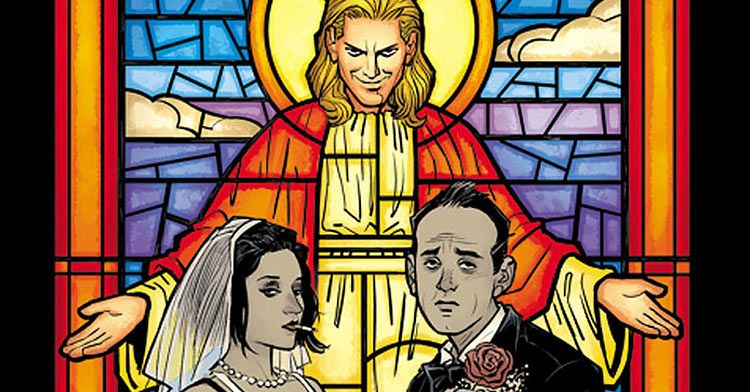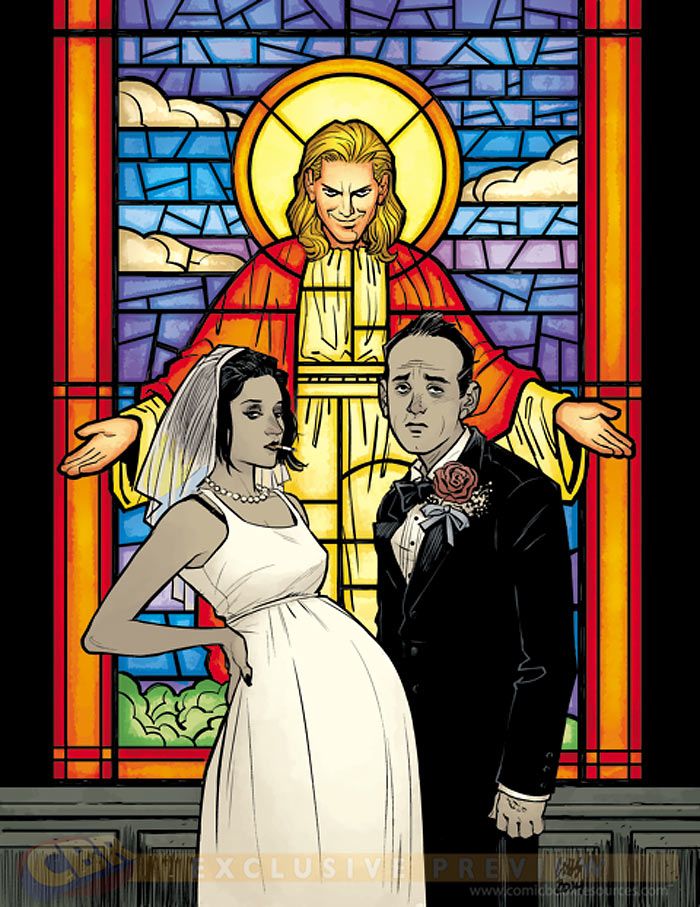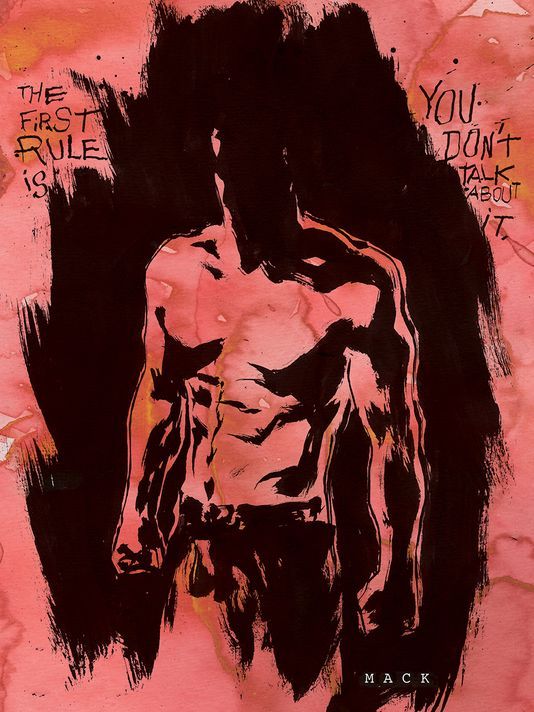Just a few days before the kick off of of Comic-Con International in San Diego 2014, Dark Horse Comics announced a long-awaited project: Author Chuck Palahniuk's sequel to "Fight Club" as a comic book series. With interior art by Cameron Stewart and covers from David Mack, the series picks up ten years after the events of the novel, finding the previously unnamed narrator (now going by the name "Sebastian") and Marla married, and judging from the first teaser image by Stewart -- found exclusively on CBR -- they're expecting a new addition to their family.
RELATED: Chuck Palahniuk Brings "Fight Club" Sequel to Dark Horse Comics
In order to get a better read on the series and the teaser image, CBR News spoke with Stewart, who provided some insight on where the characters are when the "Fight Club" sequel picks up, the design work behind the characters and the challenge of depicting them differently than their film incarnations. We also dig into how the process for "Fight Club" is different than other projects he's taken on in his career and much more.
CBR News: Cameron, tell us a bit about this image: What's going on in it, what was the approach to designing it and how did it come about?
Cameron Stewart: Actually, we've been having these creative meetings with myself, Chuck Palahniuk, [editor-in-chief] Scott Allie, [colorist] Dave Stewart, [letterer] Nate Piekos -- the entire team has been together, and we were brainstorming these ideas for what a good, striking promotional image would be. Something that would indicate to the readers that this was a follow-up to the novel, and show the characters in a tantalizing way as to what was in store for them. One of the ideas we came up with was a wedding photo between Sebastian and Marla, showing that she's pregnant, and the two of them looking not exactly thrilled at the situation.
We wanted to put Tyler in there, but we couldn't really figure out how to do it. One of the ideas that we talked about was Tyler appearing in the background of scenes or before he actually manifests himself, he's subtly there. I had the idea of working him into the stained glass -- I was doing a stained glass image, anyway. I was looking at these images of stained glass with Jesus and his arms outstretched, and I thought it would be funny to put Tyler in the Jesus position. [Laughs]
I was a little worried about it, actually. I thought, "Oh man, this is maybe not a great thing to do!" but everybody loved it -- Chuck loved it, so we went with that. The other thing, which was something I never picked up on in the original novel, is that Tyler has long hair. The image of Tyler that's in the popular culture is Brad Pitt, with the short hair and the scruff goatee. Actually, the way he looks in the novel is sort of like Chris Hemsworth as Thor. He's supposed to have that kind of hairstyle. I thought that putting him in the Jesus position with the longer hair was a good way to introduce that concept to the new audience and get them comfortable with them having long hair. At first you'd kind of assume that he's in the Jesus position in the stained glass, but I think when you see him later and he's got the long hair, it won't be quite such a jarring transition.
What's your background with Chuck Palahniuk's work? Were you a fan of "Fight Club" before coming on to do the art for this project?
Yeah! I lobbied really hard to work on this because I'm a huge Chuck Palahniuk fan. I saw the movie like everybody did, and when I heard it was based on a novel, I went out and read the novel. I loved it, and I've been a fan ever since. I haven't read every single one of his books -- there are a couple I still haven't read yet -- but I've read pretty much all of his books. I'm a big fan, I really love his writing. He's one of my favorite authors and has been for fifteen years. When I heard that this was happening -- because he announced publicly that they were doing a "Fight Club" graphic novel or comic book sequel -- I thought, "That's interesting." I never thought that I would possibly be involved with it, but when I heard it was potentially going to be at Dark Horse, whom I've had some history with, I just dove on it. I contacted Scott Allie immediately and said, "I must do this book."
RELATED: Palahniuk Planning "Fight Club" Graphic Novel Sequel
It was definitely a thing where I knew I wanted to be involved and I pushed really hard for it. I actually adapted a short sequence from the original novel as a proof-of-concept. I poured everything I had into it. I made a 3-page comic as an example of how I would handle it if I got the job, and that ended up being the thing that sealed the deal for me.
The pressure on this project must be enormous -- this has to be one of the most anticipated literary sequels of our time.
It's such a huge thing in pop culture. Everybody knows about it. There is some pressure on it, yeah. But the thing I find really liberating about it is that, because it's a sequel to the novel, not to the film, we have a little bit more freedom to play with the visuals. It's a good thing and it's a bad thing, because the film is so engrained in popular culture -- the image of Tyler Durden is Brad Pitt -- and we cannot make it look anything like Brad Pitt for various legal reasons. We have to make it look completely different, but still recognizable as those characters, which is quite a unique challenge -- to have something be immediately recognizable but completely different. It's been fun trying to accommodate and arrive at the middle ground.
Since you're working closely with Chuck Palahniuk, who likely has a vision of his own as to how the characters should look, what was the character design process like?
We just talked about it. At some of these meetings we've been having, I just picked his brain and asked him how he envisioned the characters. I asked, "What kind of hair do they have? What are they wearing?" Particularly because this is ten years after the first book, they've changed their stations in life. Marla is a housewife now, an upper-class housewife. Her manner is different now. My initial conception of what Marla looked like was informed by Chuck correcting me and saying, "Oh no, I imagined her wearing this kind of clothing and having this sort of hairstyle. She has very nice jewelry and a certain kind of watch." I took a lot of notes and I would sketch it out. For example, for Tyler's hair, I would sketch out different quick images of different hairstyles and he would pick one. It was actually kind of a quick process; I feel like I nailed it pretty early. I did some character drawings, showed them to Chuck and to Scott and they were happy almost right away. It was not a long, painful process, thankfully. [Laughs]
Working on "Fight Club," what's been most satisfying for you, as an artist?
It's still very early days, yet. At the moment, I'm just doing layouts for the first issue. One of the things we talked about was brainstorming different things, visually, that are unusual for comics, or things that maybe unsettle or at its worst annoy the reader. Try to come up with things like that where we can obscure the art or dialogue, ways to play with the comics form in a similar way the film played with the idea that Tyler was fucking with the film -- there would be moments where you would see the film jutter and the sprockets on the side. It became a meta thing. We were trying to come up with similar ideas for this -- stuff like manufactured printing errors, or the colors being slightly off-register. It's been really fun to play with those ideas and push myself to come up with these interesting narrative techniques. I don't want it to be too crazy, too ostentatious. Someone like J.H. Williams is absolutely incredible at making every single page an incredible piece of art and design. That's a little to far for what I want to do, so we're trying to keep it fairly grounded, using a grid storytelling panel, but subverting it in these key ways that contrast the rigidity of the panel structure. That's been a lot of fun.
Chuck's been really cool. He's been saying, "Surprise me." He's written it all, and I was asking questions about what I should do and he said, "You know what? Just surprise me with it." He's really excited to see what I can do with it and what I can bring to the table, and that's really satisfying.
It sounds like you've got a lot of creative freedom to take care of the comic book storytelling side of the equation.
Yeah, and one of the things that [Palahniuk]'s done -- and I think it's partly because comics is a new medium for him -- is that he's written scripts without page breakdowns. He's written it start to finish with no breaks for the pages, so I'm able to go in and identify where I feel the natural page breaks should be. He's indicated a couple of times in the script that there's an end of the page or a page turn, but for the most part, he's given me the opportunity to break it down and adapt the script into a comic, if that makes sense. But his writing is really ideally suited for it, because he's got this short narrative style with single line paragraphs that occur rhythmically. It's really nicely suited for the tick-tick-tick of a comics panel.
Is it difficult for you, as a "Fight Club" fan, knowing everything that's coming in the sequel and keeping it to yourself?
[Laughs] Yes and no. The amazing thing about this is that whatever anybody could have in mind for what a "Fight Club" sequel would be -- this is not that. That's really exciting. When I was reading it -- the first few issues are great, and maybe they would go along the lines of what you would expect for a sequel. Then it goes off the rails. I was like, "Oh, my God! I can't believe the book is going in this way." It's really absolutely what no one is going to expect in a really positive way. It's going to be baffling for a lot of people, it's going to be really interesting to see what the reaction is, and I don't want to spoil that reaction. I love knowing what's happening, and it is difficult not to talk about it, but at the same time, I don't want to spoil that. I want to see what happens when people hit that part of the story when it takes a turn for the absolutely bizarre.
RELATED: Simone Leaves "Batgirl" in the Hans of Stewart, Fletcher & Tarr
Switching gears quickly, congrats on the great fan reaction to the "Batgirl" announcement.
Oh, thank you!
Considering how positive the reaction to "Batgirl" has been, has that made you think about the reaction fans might have to the "Fight Club" sequel and your work on it?
[Laughs] Well, it's very, very different! It was actually pretty funny timing, because after I lobbied really hard to get the "Fight Club" job and I got it, it was literally two days later that DC offered me "Batgirl." I was like, "Aw!" because I really wanted to do that as well for entirely different reasons, but still something I was really excited about doing. I knew they were completely tonally different -- they're aimed at different audiences. I'm sure there will be people interested in me as a creative person that are interested in my "Batgirl" work and interested in the "Fight Club" work. There are people that are interested in "Batgirl" that probably won't be interested in "Fight Club" and vice versa.
One thing I've tried to do with my career is to do a lot of different things. I'll do a book like "Sin Titulo" and a book like "Seaguy" or "B.P.R.D." -- I try to do different things and different drawing styles, because it keeps things fresh and interesting for the audience. I feel like a lot of times they don't know what they're going to get from me. When I announce my next project, I want it to be the thing that's not expected. I want people to go, "Holy shit! That's what he's doing right now?" I think different things can be for different audiences and they don't have to aim for the same thing.
Coming so soon after each other, it's a real one-two punch -- but it's going to be something, that's for sure! It's been tough trying to design a business card for San Diego because it's like, "Which image do I use?" [Laughs]
Check back with CBR for more details on the "Fight Club" sequel, as well as an interview with cover artist David Mack.



